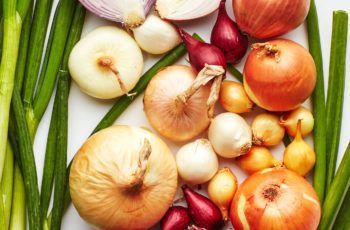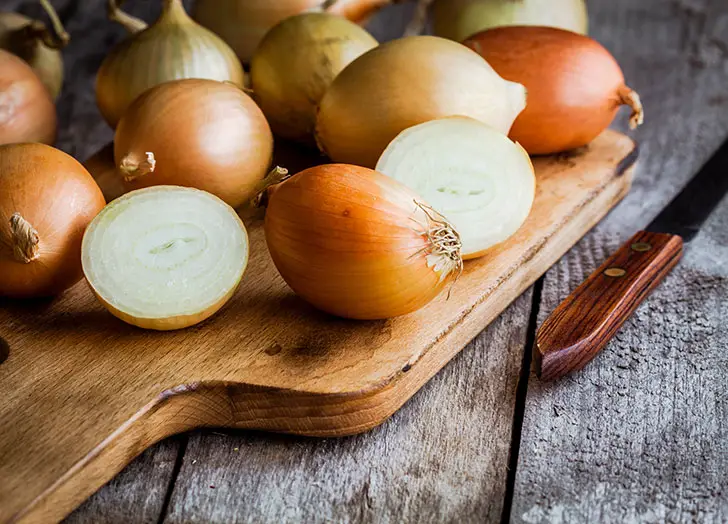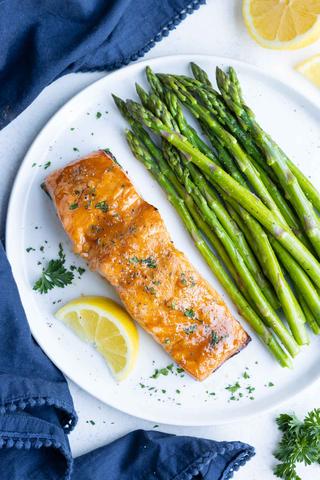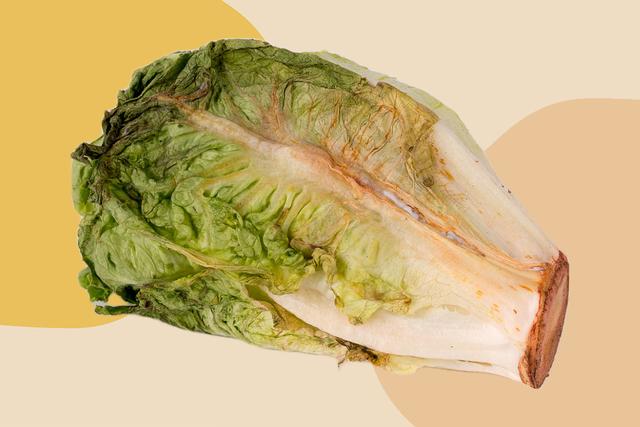
Onions are a staple in kitchens all over the world. They are used in savory dishes to add flavor and depth, as well as in desserts for sweetness and color. There are many different kinds of onions, but perhaps the most versatile is the Spanish onion. What is a Spanish onion, you ask? Keep reading to find out!

Types of Onion:
- White Onions: White onions are the most common type of onion. They have a thin, papery skin and firm, white flesh. White onions are very versatile and can be used in a variety of dishes, from soups and stews to salads and stir-fries.
- Red Onions: Red onions have deep purple skin and crisp, white flesh. They are slightly sweeter than white onions and have a milder flavor. Red onions are often used in salads, salsas, and other raw dishes.
- Yellow Onions: Yellow onions have a thin, yellow skin and white flesh that is tinged with green. They have a sharp flavor that mellows when cooked. Yellow onions are commonly used in soups, stews, and sauces.
- Spanish Onions: Spanish onions are a type of sweet onion with a milder flavor. They have thin, white skin and white flesh. Spanish onions are commonly used in salads, stir-fries, and other dishes where their sweetness can shine through.
- Sweet Onions: Sweet onions are a type of onion that is milder in flavor and crunchier in texture. They have a thin, papery skin and white flesh. Sweet onions are typically used in salads, as they add a touch of sweetness to the dish.
- Green Onions: Green onions, also known as scallions, have a long, green stalk and a white bulb. They have a mild onion flavor and are often used as a garnish or in salads.
- Spring Onions: Spring onions are a type of onion that is harvested in the springtime. They have thin, white skin and white flesh. Spring onions are typically used in salads or as a garnish.
- Shallots: Shallots are a type of onion that is small and has a mild, sweet flavor. They have thin, brown skin and white flesh. Shallots are commonly used in sauces, salads, and other dishes where their sweetness is desired.
- Cipolline (a.k.a. Cipollini) Onions: Cipolline onions are a type of onion that is small and round. They have thin, brown skin and white flesh. Cipolline onions are commonly used in salads, as they add sweetness to the dish.
- Pearl Onions: Pearl onions are a type of onion that is small and round. They have a thin, white skin and white flesh. Pearl onions are commonly used in soups and stews, as their small size makes them easy to eat.
Factors to consider when choosing an Onion:
When choosing an onion, there are a few things to keep in mind. Firstly, decide what type of dish you will be making. If you’re looking for an onion to use in a salad, then you’ll want to choose a sweeter onion, like a Spanish onion. If you’re looking for an onion to use in a soup or stew, then you’ll want to choose a more pungent onion, like a white onion. Secondly, consider the size of the onion. If you’re looking for an onion to use as a garnish, then you’ll want to choose a small onion, like a pearl onion. If you’re looking for an onion to use as the main ingredient in a dish, then you’ll want to choose a large onion, like a Spanish onion. Lastly, consider how you will be preparing the onion. If you’re going to be cooking the onion, then you’ll want to choose one with a milder flavor, like a Spanish onion. If you’re going to be eating the onion raw, then you’ll want to choose one with a sharper flavor, like a white onion.

What is a Spanish Onion?
A Spanish onion is a type of onion that is typically white with a thin skin. They are known for their sweet and mild flavor, which makes them a popular choice for dishes like salads and stir-fries. Spanish onions are also relatively low in calories and carbohydrates, making them a healthy option when cooking. If you’re looking for an onion that is versatile and can be used in both savory and sweet dishes, then the Spanish onion is a great choice.
Spanish onions are available year-round, but they are at their freshest in the springtime. When selecting a Spanish onion, look for one that is heavy for its size and has firm, dry skin. Avoid onions that have any green sprouts coming from the top, as this is a sign that they are past their prime. Store your Spanish onion in a cool, dry place, and it will keep for up to two weeks.
What Does a Spanish Onion Look Like?
A Spanish onion is a type of onion that is typically white or yellow with a thin skin. They are known for their sweet and mild flavor, which makes them a popular choice for dishes like salads and stir-fries. Spanish onions are also relatively low in calories and carbohydrates, making them a healthy option when cooking. If you’re looking for an onion that is versatile and can be used in both savory and sweet dishes, then the Spanish onion is a great choice.
Are Spanish Onions Sweet?
Yes, Spanish onions are typically sweet and mild in flavor. This makes them a popular choice for dishes like salads and stir-fries. Spanish onions are also relatively low in calories and carbohydrates, making them a healthy option when cooking. If you’re looking for an onion that is versatile and can be used in both savory and sweet dishes, then the Spanish onion is a great choice.
What is the Nutritional Value of a Spanish Onion?
Spanish onions are a good source of fiber, vitamin C, and iron. They are also low in calories and carbohydrates, making them a healthy option when cooking. If you’re looking for an onion that is versatile and can be used in both savory and sweet dishes, then the Spanish onion is a great choice.
How to Cut a Spanish Onion
Cutting a Spanish onion is relatively simple. First, cut off one end of the onion and peel it so that the edible layer is exposed. Cut the onion in half so that the uncut end from before is divided in two, then slice the onion in half again. Finally, slice the onion into thin strips. Watch the video below for a visual demonstration of how to cut a Spanish onion.
Spanish Onion Substitutes
If you cannot find a Spanish onion, then you can substitute another type of onion in its place. White onions, yellow onions, and red onions are all good substitutes for Spanish onions. They may have a slightly different flavor, but they will still work well in most recipes.
Where Can I Buy Spanish Onions?
Spanish onions are available at most grocery stores. They are typically sold in the produce section near other types of onions. You can also purchase Spanish onions online from various retailers.
How to Store Spanish Onions
Store your Spanish onion in a cool, dry place, and it will keep for up to two weeks. If you need to store your onion for longer than that, you can chop it up and freeze it for future use.
Recipes Using Spanish Onions
There are many different recipes that you can make using Spanish onions. Some popular dishes include onion soup, caramelized onions, roasted potatoes with onions, and grilled onions. No matter what dish you’re making, Spanish onions are a great choice.
How to Plant Yellow Sweet Spanish Onions
To plant your own yellow sweet Spanish onions, start by purchasing onion bulbs from your local garden center or nursery. Plant the bulbs in well-drained soil in an area that receives full sun. Be sure to space the bulbs about 6 inches apart so that they have room to grow. Water the onions regularly and fertilize them every few weeks. When the onions are about 4 inches tall, you can begin harvesting them. To learn more about growing yellow sweet Spanish onions, watch the video below.
When to Harvest Spanish Onions?
For the best flavor, Spanish onions should be harvested in the fall. However, they can be harvested at any time during the growing season. To harvest your onions, simply pull them out of the ground and brush off any excess dirt. Then, cut off the root end and the green leaves. Your onion is now ready to be used in any recipe.
Tips for Using Spanish Onions
Here are a few tips to help you get the most out of your Spanish onions:
– When cutting onions, be sure to use a sharp knife to avoid crushing them.
– To reduce tearing up while cutting onions, you can try chilling them in the fridge for an hour or so before chopping them.
– To add a bit of sweetness to savory dishes, try caramelizing your onions before adding them to the recipe.
– Onions can be used in both sweet and savory recipes. Try them in pies, cookies, cakes, and other desserts for a unique flavor.

Spanish Onion vs Yellow Onion- What’s the Difference?
The main difference between Spanish onions and yellow onions is their flavor. Yellow onions have a sharp, pungent flavor that is ideal for savory dishes. Meanwhile, Spanish onions are sweeter and milder, making them better suited for sweet or mellow recipes. However, both types of onions can be used in a variety of dishes. So, if you can’t find a Spanish onion, a yellow onion will work just as well.
FAQs
Are Spanish Onions a Healthy Food?
Yes, Spanish onions are healthy food. They are low in calories and fat, and they are a good source of fiber and vitamins. Onions also contain antioxidants that can help to protect your cells from damage.
Do Spanish Onions Have a Strong Flavor?
No, Spanish onions do not have a strong flavor. They are actually quite mild and sweet. This makes them ideal for dishes where you don’t want the onion flavor to be too overwhelming.
Can I Eat Spanish Onions Raw?
Yes, you can eat Spanish onions raw. In fact, many people prefer to eat them raw because they are so sweet and mild. If you do choose to eat them raw, be sure to wash them thoroughly first to remove any dirt or bacteria.
How Do I Choose a Good Spanish Onion?
When choosing a Spanish onion, look for one that is firm and has dry, papery skin. Avoid onions that are soft or have brown spots. You should also sniff the onion before purchasing it. A good onion will smell fresh and slightly sweet.
Will Chopping Spanish Onions Make You Cry?
No, chopping Spanish onions will not make you cry. This is because they are much milder than other types of onions, such as yellow onions. So, if you’re looking to avoid tears while chopping onions, be sure to choose a Spanish onion.
Learn More About Grilling
If you want to learn more about grilling, check out these other helpful resources!










